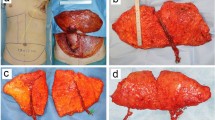Abstract
Breast cancer develops in the lifetime of 12% of women. Breast reconstruction increases the quality of life in these women. There are different surgical options for breast reconstruction: immediate or delayed prosthesis-based reconstruction, oncoplastic reconstruction, fat grafting, and free or pedicled flap reconstructions. Different techniques leave different scars on the breast. Here, we present a woman with a breast scar after breast reconstruction using a deep inferior epigastric perforator (DIEP) flap.
You have full access to this open access chapter, Download chapter PDF
Similar content being viewed by others
Keywords

A 47-year-old woman visited the outpatient clinic because of a scar on the right breast. She previously underwent deep inferior epigastric perforator (DIEP) flap breast reconstruction after nonskin, non-nipple-sparing mastectomy, chemo- and radiotherapy, because of breast cancer . She had attended her oncological regular check-ups without problems. She now complained of a painful scar on the right breast, which she also found unaesthetic.
FormalPara Questions (4 max)-
Q1. Which anatomic areas need to be examined as well during outpatient clinic consultation?
-
Q2. Define the problems in terms of anatomy.
-
Q3. What could be a (non-)surgical approach of the problem?
-
Q4. What should always be checked in postoncological patients before surgery?

In one surgical session, a donor-site dogear correction, scar lipofilling, and contralateral breast reduction were performed. Liposuction was used to correct the excess of fat at the region of the abdominal scar. The same fat was used for lipofilling of the upper pole of the right breast and the right breast scar. Nipple tattooing was performed at the outpatient clinic.

With 24 months of clinical follow-up, the patient was fully satisfied with the end result.
Argumented answers and explanation according to the five references (cited later): 20 lines
-
Q1. Which anatomic areas need to be examined as well during outpatient clinic consultation?
-
A1. The contralateral breast, the donor-site scar, and possible donor sites for future fat harvesting.
-
Q2. Define the problem in terms of anatomy .
-
A2. There is volume asymmetry between the left and right breasts. Right breast: lack of nipple, irregularities, and volume deficit of upper pole. Donor site: dogears, scar irregularities, and scar hypertrophy.
-
Q3. What could be a nonsurgical approach of the problem ?
-
A3. Silicone application on all hypertrophic scars.
-
Q4. What could be a surgical approach of the problem ?
-
A4. Donor-site dogear correction, nipple plasty or tattooing, scar lipofilling, contralateral breast reduction, or a combination of these strategies.
-
Q5. What should always be checked in postoncological patients before surgery?
-
A5. If they have attended routine oncological checkups.
1 Conclusion
There are different surgical options for breast reconstruction: immediate or delayed prosthesis-based reconstruction, oncoplastic reconstruction, fat grafting, and free or pedicled flap reconstructions [1,2,3,4]. Different techniques leave different scars on the breast. Nonsurgical approaches for breast scarring after reconstruction are silicone application and/or corticosteroid injections. Physical examination should always include examination of the contralateral breast, the donor-site scar, and possible donor sites for reconstructive purposes. There is a great role for autologous fat grafting in these reconstructive procedures. Other (minor) corrections can be performed simultaneously.
Take-Home Message
-
Scar problems after various types of breast reconstruction are common. Many different corrections can be combined in one or multiple sessions.
References
Ho PJ, Hartman M, Young-Afat DA, Gernaat SAM, Lee SC, Verkooijen HM. Determinants of satisfaction with cosmetic outcome in breast cancer survivors: a cross-sectional study. PLoS One. 2018;13:e0193099.
Jaspers ME, Brouwer KM, van Trier AJ, Groot ML, Middelkoop E, van Zuijlen PP. Effectiveness of autologous fat grafting in adherent scars: results obtained by a comprehensive scar evaluation protocol. Plast Reconstr Surg. 2017;139:212–9.
Mureau MAM, Breast Reconstruction Guideline Working Group. Dutch breast reconstruction guideline. J Plast Reconstr Aesthet Surg. 2018;71:290–304.
van Turnhout AA, Fuchs S, Lisabeth-Broné K, Vriens-Nieuwenhuis EJC, van der Sluis WB. Surgical outcome and cosmetic results of autologous fat grafting after breast conserving surgery and radiotherapy for breast cancer: a retrospective cohort study of 222 fat grafting sessions in 109 patients. Aesthet Plast Surg. 2017;41:1334–41.
Author information
Authors and Affiliations
Corresponding author
Editor information
Editors and Affiliations
Rights and permissions
Open Access This chapter is licensed under the terms of the Creative Commons Attribution 4.0 International License (http://creativecommons.org/licenses/by/4.0/), which permits use, sharing, adaptation, distribution and reproduction in any medium or format, as long as you give appropriate credit to the original author(s) and the source, provide a link to the Creative Commons license and indicate if changes were made.
The images or other third party material in this chapter are included in the chapter's Creative Commons license, unless indicated otherwise in a credit line to the material. If material is not included in the chapter's Creative Commons license and your intended use is not permitted by statutory regulation or exceeds the permitted use, you will need to obtain permission directly from the copyright holder.
Copyright information
© 2020 The Author(s)
About this chapter
Cite this chapter
van der Sluis, W.B. (2020). Scars After Breast Reconstruction. In: Téot, L., Mustoe, T.A., Middelkoop, E., Gauglitz, G.G. (eds) Textbook on Scar Management. Springer, Cham. https://doi.org/10.1007/978-3-030-44766-3_62
Download citation
DOI: https://doi.org/10.1007/978-3-030-44766-3_62
Published:
Publisher Name: Springer, Cham
Print ISBN: 978-3-030-44765-6
Online ISBN: 978-3-030-44766-3
eBook Packages: MedicineMedicine (R0)




